
The Syrian Arab Air Force (SyAAF) was established in 1948. Since the rise of the Ba’ath Party to power in 1966, the armed forces of Syria benefited greatly when the nation allied itself to the Soviet camp, which contributed to the reinforcement and modernization of all the branches of the Syrian Armed Forces, most importantly developing and rebuilding the Syrian Air Force.
The Syrian Air Force numbers nearly 40,000 officers and soldiers including pilots, technicians, and navigators. Its command is based in the capital Damascus. It is currently led by General Issam Hallaq. The late President Hafez al-Assad is considered one of the most important personalities in the establishment of the force, having served in the Syrian Air Force as one of the first group of pilots in the 1950s.
The Syrian Air Force participated in all conflicts and battles Syria has engaged in since its establishment, including the repulsion of the Israeli assault during the 1967 War and the joint Syrian-Egyptian attack that was conducted in the 1973 War. The Syrian Air Force also participated in the Lebanese Civil War from 1978 until its end in 1991.
The Syrian Air Force owned 575 fixed-wing aircraft before the beginning of the current war of the following variety:
The Syrian Air Force operates the following varieties of fighters and helicopters:
Mig-21: Light Soviet-era fighter jet. Considered to be one of the oldest fighters in the SyAAF. At the outset of the new millennium, the SyAAF owned some 200 of those jets from the MF/Bis variety. By 2011, only 70 were still in service, mostly for training purposes. Today only 40 of these jets remain operational, after heavy losses of warplanes of this type during the current conflict.
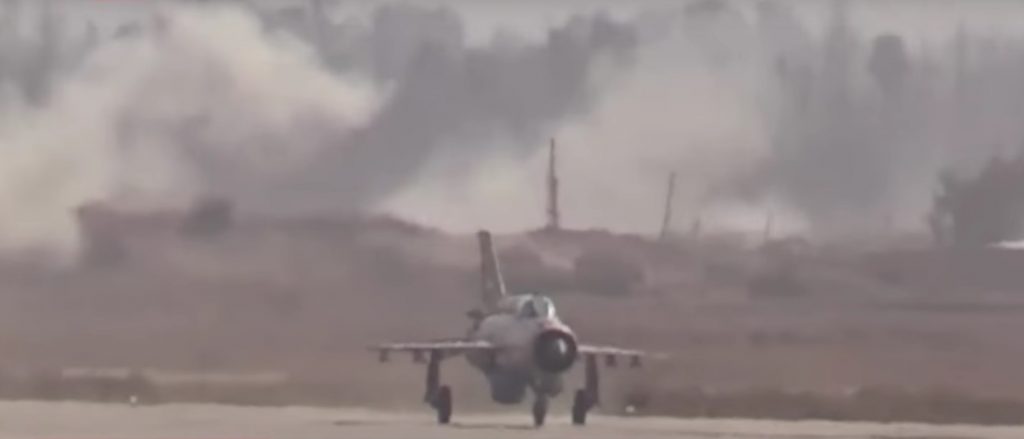
Figure 1. Syrian Air Force fighter on Deir Ezzor airfield after a combat mission
Mig-23: Soviet fighter operated by the SyAAF for decades. Nearly 40 MIG-23s of a number of different variants were in operation; however, the Syrian Air Force has lost most of these aircraft in the current war, attributable to combat loses, airfield capture and attrition.
Mig-25: Soviet supersonic interceptor and reconnaissance aircraft. 30 fighters were owned by the Syrian Arab Air Force before the current conflict. Only two remain in service. Their fighting capacity was already in doubt at the beginning of the war, because the aircraft are of limited utility as they are solely meant to interdict other aircraft. According to unconfirmed reports, they only participated once in the ongoing war, in the skies over Latakia, 2013.
Mig-29: Multi-purpose Soviet fighter jet. Considered the most modern jet in the Syrian Air Force. All of the warplanes were developed by Russia prior to 2011 to the MIG-29sm/Sy specification, designed specifically for Syria as the abbreviation denotes. The fighter jets were optimized with the newest radar systems at the time and the capability of carrying advanced air-to-air and air-to-ground missiles. Syria owns 30 of these jets and another two jets of the advanced training UB variety.
Su-22: Soviet ground-attack aircraft. Syria had perhaps 30 SU-22s of the m3 and m4 variants; however, most of those jets have been lost during the ongoing war.
Su-24: Advanced Soviet ground-assault warplane. Syria had owned 20 of these tactical attack jets of the MK2 variety which possess relatively modern navigation systems, advanced targeting radar, and the ability to use air-to-ground missiles. Only 15 jets remain operational after 6 years of brutal war.
L-39: Czechoslovakian advanced jet trainer. SyAAF owns 40 jets of the ZO/ZA variant. This jet was used for close air support during the current war. Its first recorded use in combat was in Aleppo 2012, where it bombed invading FSA fighters. The SyAAF lost roughly half of these light aircraft, with an estimated 20 or so remaining in service.
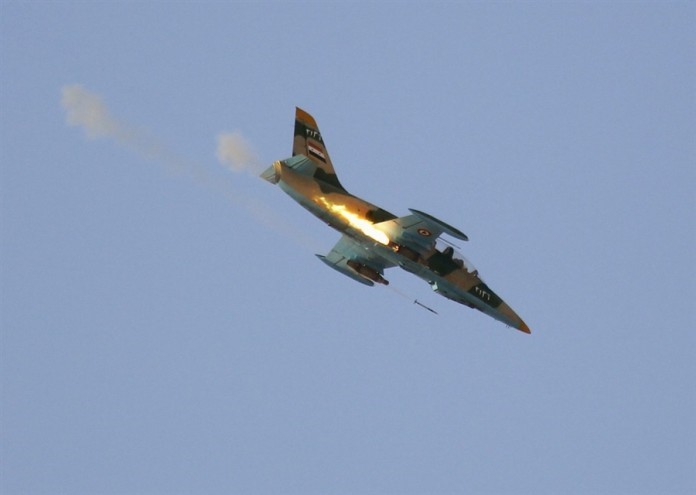
Figure 2. SyAAF L-39 performs combat mission
Mi-25: Soviet attack helicopter. 30 helicopters of this type were in operation by the SyAAF prior to the war. It was first used in Aleppo’s countryside in 2012. Now 15 or less of these helicopters remain operational.
SA342L Aerospatiale Gazelle: French-manufactured light assault helicopter. The Syrian Airforce had 30 helicopters at the beginning of hostilities. Very few of these helicopters have been lost over the course of the war. Apparently, they are not heavily utilized, one of the main reasons being that there are problems with the supply of spare parts from the manufacturer. Gazelles have been used several times in Syria during its civil war, most recently observed supporting troops in the Palmyra Offensive using unguided missiles and HOT ATGMs.
MI-8/ MI-17: Soviet multi-purpose transportation helicopters. SyAAF owned 130 of these helicopters in 2010. Between 50 and 60 remain operational as many have been lost over the course of the war. Syria had developed some examples of these helicopters with electro-optical navigation systems, as well as arming some with bombs to carry out offensive operations.
Moreover, the SyAAF owns several transport planes including an AN-24, six An-26s, three Il-76 long range strategic transports, four Tu-134 planes, and four Yak-40 aircraft, all of which were registered as civilian aircraft in peace time.
In total, the Syrian Air Force can rely on approximately 200 combat aircraft, 110-120 attack and transport helicopters and about 20 passenger and cargo aircraft as part of its current inventory.
The SyAAF utilizes a variety of ammunition:
Non-guided bombs operate on most fighter jets:
Traditional FAB bombs
ODAB vacuum bombs
RPL cluster bombs
Extremely-explosive OFAB bombs
ZAB combustion bombs
BETAB anti-fortifications bombs
Guided missiles:
Laser-guided KAB-500/1500I bombs which operate on the Su-24mk2 attack aircraft.
Television-guided KAB-500/1500kr bombs which operate on the MiG-29sm fighter and Su-24mk2 attack aircraft.
Non-guided rockets:
The SyAAF utilizes many non-guided air-to-ground rockets on most of its fighters and helicopters of the S-24/s-5/s-8 varieties.
Air-to-ground guided missiles:
Kh-23: Radio command guided missiles with 10 km range equipped by the Mig-23bn/ Su-22m3/ Su-22m4 aircraft.
Kh-25ml: Laser-guided missiles with a range of 11 km equipped by Su-22m4 and Su-24mk2 bombers.
Kh-29: 10 km range laser or television guided missile Kh-29I variant, and 12 km range Kh-29t variant. Mig-29sm and Su-24mk2 jets can utilize these rockets.
Kh-31: The Kh-31a is an anti-ship missile with a 100km range.
The Kh-31p is anti-radar missile with a range of a 100 km. Both variants of the Kh-31 can be carried by both the Mig-29sm and Su-24mk2.
Kh-35e: Anti-ship missile with a 130 km range. Equipped by Su-24mk2 and Mig-29sm warplanes.
HOT: Guided anti-tank missiles with a 4 km range. Utilized by the Gazelle helicopter.
Air to Air Missiles:
R-13M: Old Soviet era air to air missile. It is IR-guided, with a range of up to 35km. It is only used on the Air Force’s Mig-21s.
R-60: Short range soviet IR-guided missile, with a range of 8km. Used mainly on the Mig-23.
R-73: Advanced short range Soviet IR-guided missile, with a range of approximately 30-40km. Equipped on the Mig-29sm fighter units of the Air Force.
R-23R\T: Medium range Soviet air to air missile. The R variant is semi-active radar guided while the T is IR guided. Main air-to-air armament of Mig-23.
R-77: Advance air-to-air active radar guided missile with a range of more than 80km. Main armament of the Mig-29sm.
Before discussing the established air bases and organization of the various Syrian Air Force units which are based at these facilities, it should be noted that the Syrian Air Force was built on the model of the USSR Air Force. According to the requirements of a bomber or fighter squadron of the Soviet Air Force circa the 1970-80s, there could be between 10 to 20 aircraft per squadron, and in the helicopter squadrons, between 8 to 14 helicopters. In addition, during the 6 years of the current civil war, many units ceased to exist as combat units. Combat tasks are currently performed by individual vehicles or small groups of aircraft (helicopters) created ad hoc. Nearly all machines capable of performing combat missions were rapidly concentrated in central and western Syria, mainly at the air bases of Mazzeh (Damascus), Shayrat (Homs), Tiyas(T4) (near Palmyra), Kuweiris (in Aleppo) and on air fields near Latakia and Deir-ez-Zor.
The SyAA operates 21 air bases across Syria:
Abu al-Duhour: Positioned in the Idlib countryside. Jabhat al-Nusra managed to capture it on the 9th of September 2015 after a siege that lasted two years and 11 months. The 678th Squadron with MiG-23MS and 2th Squadron with L-39ZO aircraft were based there.
Al-Quseir: Located in the Homs countryside. Militants from the Free Syrian Army and al-Nusra were able to capture it in 2013, only to loss it again to the Syrian Armed Forces a few months later. The 825th Squadron which is equipped with are based there.
Al-Nasiriyah: Located in Damascus province. Played a significant role in the decisive battles of Western Qalamoun. The 695th Squadron with MiG-23BN/UB and 698th Squadron with MiG-23BN/UB are based at the facility.
Al-Nayrab: Located in Aleppo city. The airbase was attacked by FSA and al-Nusra militants many times with zero success. Al-Nayrab played a decisive role in the Battle for Aleppo and the east Aleppo clashes. Two squadrons with Mi-8 Hip C/H (unit unknown), two squadrons with L-39s (units unknown) and a further 2 squadrons equipped with L-39s.
Al-Tha’alah: Present in Suweida’s countryside. Attacked by al-Nusra and the allied FSA in 2015 to no avail. It protects the western flank of Suweida’s provincial capital. Based here are the 765th Squadron and 766th Squadron, both equipped with Mi-25s.
Al-Dumeir: Located north of Damascus in the Syrian desert. The airbase played an important role in halting several attacks on the capital in 2012. A squadron equipped with MiG-25Rs, one squadron with MiG-23MLs, and a squadron of Su-22M-2s (all units unknown/unnamed) are based at Al-Dumeir.
Hama: Located northwest of the provincial capital of the same name. Aircraft based here played an important role in aborting at least five militant offensives on Hama by al-Nusra, now renamed Fateh al-Sham, since 2012. It is considered a center for Russian presence inside the country. The 679th Squadron with MiG-21MF/UMs, 680th Squadron with MiG-21MF/UMs, and an unknown Squadron with MiG-29s are based there.
Hamdan: Located at Albukamal in Deir-ez-Zor’s countryside. The airport went out of service when ISIS seized it in 2014. The 8th Squadron equipped with MiG-21MF/UMs had been based there.
Jirah: Situated in Aleppo’s eastern countryside. It was captured by the FSA, Nusra, and Ahrar al-Sham in 2013, only to be seized by ISIS the following year. It is currently in no-man’s-land as it is believed that ISIS withdrew from the airport along with most of Aleppo’s eastern countryside. As of May 11, 2017, government forces took offensive actions from three sides, seeking to oust militants from the airbase. Earlier in the conflict, the 10th Squadron with L-39ZAs was based at Jirah.
Khalkhalah: Located in Suweida’s countryside. It provides air support to Syrian forces operating in Dara’a. Based here are the 945th Squadron and the 946th Squadron, both equipped with the MiG-21Bis.
Kuweiris: Air Force Academy HQ located in east Aleppo. The airport was besieged in 2012 by the FSA and al-Nusra. ISIS would later besiege the airbase after the terrorist group captured most of Aleppo’s eastern countryside in 2014. All of these militant groups failed to seize Kuweiris from the resilient Syrian soldiers holed up in the base. The siege was lifted in 2015 by the Tiger Forces with the aid of Russian air support. The 3rd Squadron equipped with L-39ZAs, and a number of MBB 223 Flamingos (propeller driver light trainer) are stationed at the base.
MarjRahal: Located south of Damascus. Provides air support to Syrian forces operating in Damascus. The 54th Squadron of MiG-23MLs, 77th Squadron with MiG-23ML/UMs, and 767th Squadron equipped with Mi-25s are based there.
Marj al-Sultan: Helicopter airbase located in Eastern Ghouta. Jaish al-Islam seized it in 2012 and the Syrian Army managed to recapture it in late 2015. The airbase hosts the 525th Squadron with Mi-8 Hip C/H, 537th Squadron with Mi-8 Hip C/H, 909th Squadron Mi-8 and an unknown/unnamed Squadron with Mi-8 Hip H/J/Ks.
Mazzeh: Located south-west of the old center of Damascus. It was reported in mid-2013 that it was “used by Syria’s elite Republican Guards, Special Forces and Air Force Intelligence.” The 976th and 977th Squadron, both equipped with SA-342-L Gazelle helicopters, had originally been based here.
Menagh: Helicopter airbase in Aleppo’s northern countryside. Besieged by the FSA and ISIS in 2012, only to be captured in a joint FSA-ISIS offensive on the airbase the following year. YPG forces would eventually capture it from Turkish-backed rebels in 2016. The 4th Squadron with Mi-8 Hip C transport helicopters and a number of MBB 223 Flamingo light trainers had originally been based at Menagh.
Qabr al-Sati: Out-of-service helicopter airbase. At the beginning of the current conflict, the 532th Squadron equipped with Mi-2, Mi-8 Hip C/H helicopters had been based here.
Shayrat: One of the most important Syrian airbases in the eastern sector of the Homs province. The aforementioned airport participated in repelling many ISIS assaults in the Syrian desert in addition to Palmyra’s recapture on two separate occasions in 2016, and subsequently in 2017. It was subjected to a US cruise-missile attack on the 7th of April, 2017, following the alleged chemical attack in Khan Sheikhoun. It was put back into service the following day. Three Mig-23mld warplanes, four Su-22m4 bombers, and a number of out-of-service planes were destroyed according to unconfirmed reports. The base is home to the 675th Squadron of MiG-23MF/UMs, the 677th Squadron equipped with the Su-22M-2, and 685th Squadron which uses the Su-22M-4.
Figure 3. Map of airports and air bases in Syria
Tabqa: Located south of Tabqa city in Raqqa’s western countryside. Subjected to a brutal siege in 2013 by FSA and al-Nusra militants following their capture of Tabqa and Raqqa. ISIS would later besiege and capture the strategically important airbase in 2014, torturing and executing the 1000 Syrian soldiers and officers who surrendered. The US-backed Syrian Democratic Forces (SDF) would capture the airport in 2017 as part of their Raqqa offensive ‘Euphrates Wrath’. Before its envelopment and capture, the 12th Squadron of MiG-21MF/UMs and 24th Brigade with Mi-8s were based there.
Taftanaz: Located in Idlib’s eastern countryside. Fighters from al-Nusra and the FSA captured the helicopter base after long, fierce battles. Early in the conflict, 253rd and 255th Squadron Mi-8 Hip C/H transport helicopter were deployed at Taftanaz.
Tiyas (T4): One of Syria’s most important airbases, located in the center of the country west of Palmyra. The ISIS terrorist group attempted to capture it on two separate occasions, only to fail disastrously. Fighter jets deployed on the imperative airbase have provided air support to Syrian Army operations across the entire country and especially in Hama, Deir-ez-Zor, Palmyra, and Damascus. The varied assets of the 1st Squadron, equipped with MiG-25PD/PU/RBs, 5th Squadron with MiG-25PD/PU/RBs, 819th Squadron with Su-24MKs and the 827th Squadron utilizing Su-22M-4s are based at the strategically important airfield.
Syrian Air Force is also operating from two civilian airports during this war:
Deir-Ez-Zor airport: The FSA laid siege to the Deir-ez-Zor beginning in 2012. Mig-21s were relocated to the airport so that they could provide the SAA defending Deir-Ez-Zor with close air support. By 2014 ISIS was able to target the airport itself; however, Syrian fighter jets continued operating from it. A number of MiG-21MF/UM from the 8th squadron are based there.
Qamishly airport: Located virtually right on the Turkish – Syrian border. In 2012 the Syrian Air Force deployed many MiG-21s there which provided the SAA and Kurdish forces with close air support against ISIS in many cases. The airport has a runway with a length of 3600 meters, which allows for the operation of all types of aircraft, including heavy transport. In early 2016, the Russian military carried out the re-equipment of the base.
Syrian Air Force in the Civil War
The fighting that began in 2011 and spread to encompass the entire country by 2012 to 2013, forced Damascus to use all of the resources at its disposal, including obsolete equipment. Dozens of aircraft and helicopters were lost during the attacks on the bases seized by anti-government forces, but in the overwhelming majority of these were older aircraft, in varied states of disrepair which were not considered operational. Therefore, the daily sorties flown in less than ideal conditions, especially considering the high likelihood of execution if shot down and captured, and while flying aircraft that were not maintained and serviced as would normally be the case, showcases the dedication and bravery of the pilots of the Syrian Arab Air Force in their collective struggle to preserve their country.
On March 20, 2014, a sortie conducted by a Syrian pilot flying a Su-24MK bomber from a government controlled airbase decided the fate of the ancient Hospitaller’s stronghold – Krak des Chevaliers near Homs, which was captured by terrorists in 2013. A high-precision munition dropped from the aircraft made a breach in the fortifications, which was used by the Syrian army special forces to breach the castle and kill the terrorists occupying it. This effort ensured the preservation of the historic fortress, as a multi-day shelling by conventional artillery would have reduced it to ruins.
One example of the heroism displayed by pilots of the Syrian Air Force is in their support of the SAA units encircled in the area of the city of Deir-ez-Zor. While piloting the MiG-21s they have to taxi and take off from the runway while under mortar fire, and then attack the enemy, who are entrenched only a few hundred meters from the runway. At the same time, the pilot has minimal chances of remaining alive if shot down, as there is little chance of rescue under the circumstances, and if he finds himself in the hands of the terrorists, a quick death by being shot would be the most preferable fate. The transfer of reinforcements and the supply of the group of government troops defending the city is only possible via air and is carried out by the forces of transport aviation, primarily by helicopters.
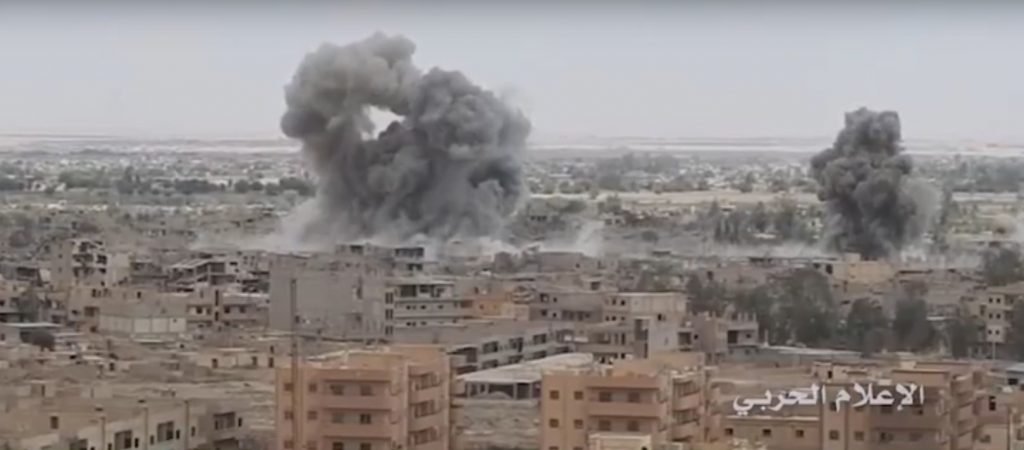
Figure 4. Syrian airstrikes target ISIS positions in Deir-ez-Zor (May, 2016)
On January 6, 2016, the Syrian Army Air force (SyAAF) carried out sorties of air raids on the rebel stronghold of Douma to the northeast of Damascus. The air strikes were conducted in response to another deadly mortar attack on several districts in the capital that killed 1 civilian and injured 12 others.
By March 29, 2016, the Syrian Air Force had conducted over 45 airstrikes in the eastern sector of the Damascus Governorate town of Jobar, targeting the movements and hideouts of Hay’at Tahrir Al-Sham and Faylaq Al-Rahman. The large number of air raids have inflicting heavy damage on the jihadist defenses.
On July 9, 2016, the SYAAF in conjunction with the Russian Aerospace Forces, carried out a multitude of air strikes targeting jihadist movements in north Aleppo. The main factions targeted by more than 20 airstrikes, were the Islamist factions of Jabhat Al-Nusra and Nouriddeen Al-Zinki. The air strikes struck the towns of Kafr Hamra, Babis, and Hreitan and its adjacent farms. No specific casualty count was provided, but given the intensity of the air strikes, there were most likely heavy casualties.
On July 27, 2016, the Syrian Arab Air Force had flown a number of sorties over ISIS-held terrain in eastern Hama. Airstrikes were particularly fierce over Qulaib Al-Thour, as Syrian intelligence indicated this village was the site of a newly built Islamic State headquarters, used by ISIS commanders to direct attacks on northern Palmyra and the eastern outskirts of Salamiyah. The building was completely destroyed; however, no information is available confirming the resultant death toll.
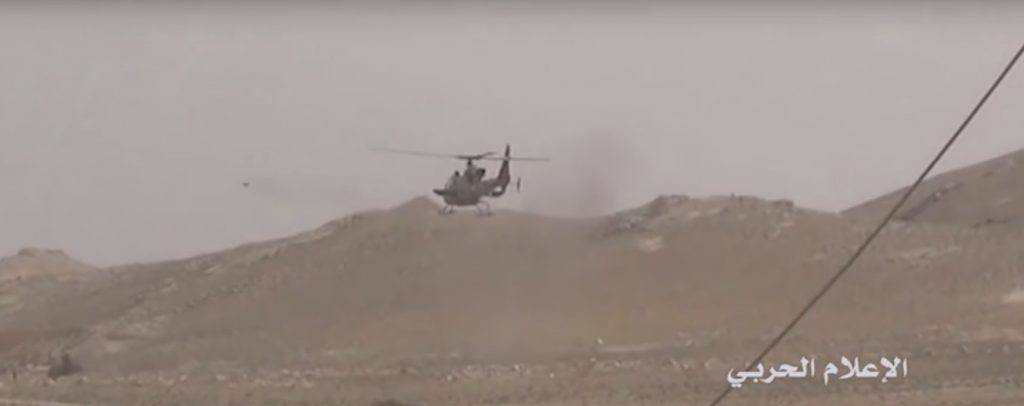
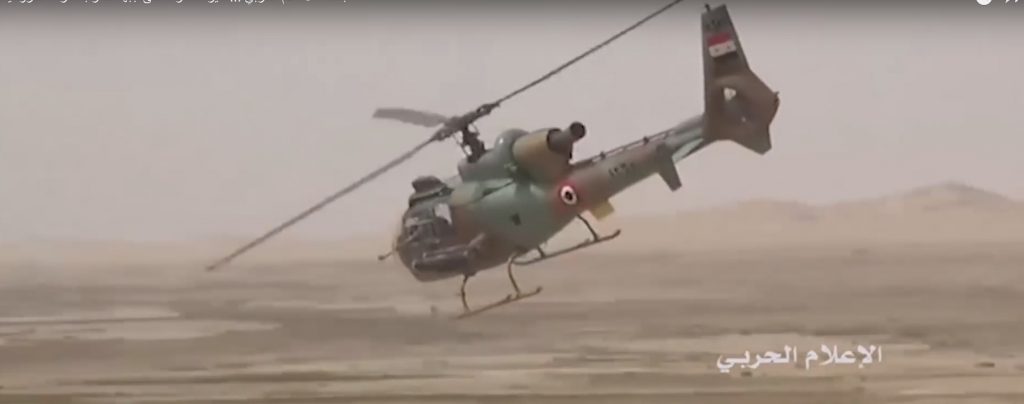
Figure 5. SA342L Aerospatiale Gazelle near Palmyra in 2016
On October 25, 2016, the Syrian Air Force targeted ISIS gathering points all over the city of Deir Hafer, which lies in the eastern countryside of the heavily contested Aleppo province. As a result of the relentless aerial bombardment of the terrorist group, dozens of Islamic State fighters were killed while six technical vehicles were destroyed.
On November 11, 2016, a series of pinpoint SyAAF air raids throughout the day destroyed at least 3 tanks, 5 armored vehicles and resulted in the deaths of numerous insurgents of Jaysh al-Fateh in northern Hama.
Then on February 14, 2017, with sorties being carried out by the hour throughout the day, the SyAAF struck numerous insurgent positions in Daraa city. Although the exact death toll on both sides remained unclear by the end of the day, one pinpoint airstrike did manage to set alight a rebel tank, trapping its entire crew inside the burning vehicle.
On March 30, 2017, the Syrian Arab Air Force destroyed the Islamic State’s massive base in Albukamal, while also killing a large number of terrorist combatants. In addition to destroying this base, the Syrian Air Force also destroyed 39 other Islamic State sites inside the Deir Governorate, thanks in large part to the collaboration of Iraqi military intelligence.
Then on April 3, 2017, warplanes and attack helicopters of the Russian Air Force once again provided air cover for the Syrian Army in its fight against Islamist militants in Hama province. The Syrian Arab Air Force also carried out coordinated operations with the Russian Air Force and Syrian Army in the province. According to sources in Syria, attack helicopters destroyed a convoy of vehicles, killing an unknown number of terrorists. The bulk of the airstrikes were carried out on Halfaya, Taibat al-Imam, Maarkabeh, and Aqrab.
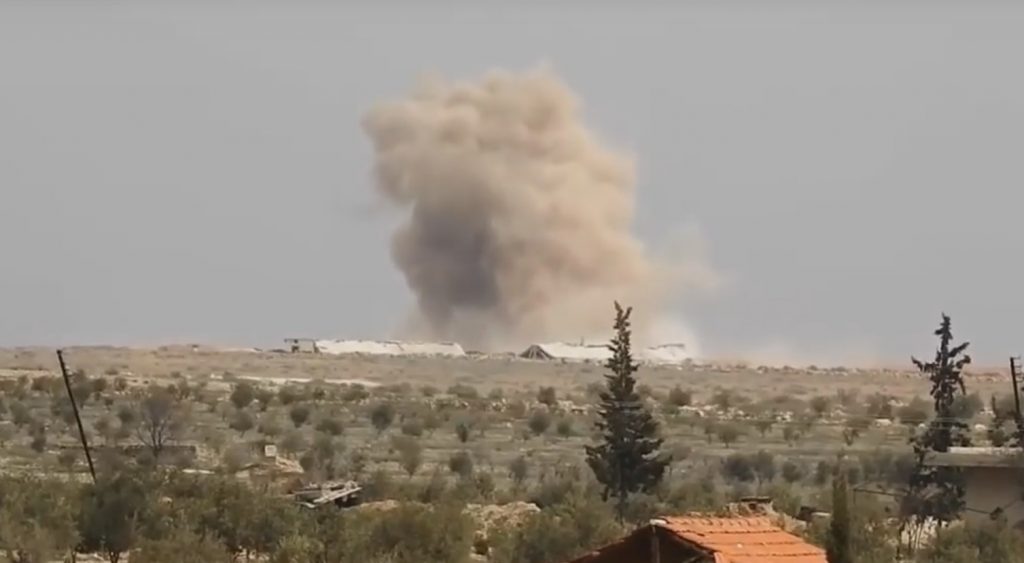
Figure 6. SyAAF air strike near Hama (April 2017)
On April 28, 2017, the Russian & Syrian Air Forces deploying thermobaric parachute bombs on a massive scale in an effort to defeat Hay’at Tahrir al-Sham in central Syria. The photo above shows deadly bombs landing at Al-Latamneh, a military headquarters for the Al-Qaeda linked group Hay’at Tahrir al-Sham,and Jaysh al-Issa.
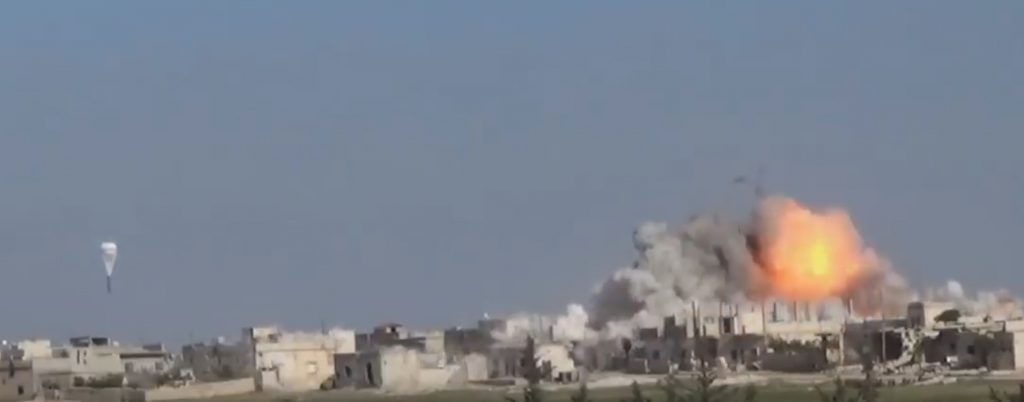
Figure 7. Thermobaric parachute bombs dropped by the SyAAF on insurgent positions near Latamneh (April 27, 2017).
Following up on May 9, 2017, Syrian aviation dealt a massive blow to IS fighters in the Al-Makaber region (Deir-ez-Zor province), which reportedly resulted in the elimination of a large number of terrorists, as well as 15 cars with large-caliber machine guns. Also on this day, the Syrian air force inflicted massive strikes on the positions of terrorists in the city of Muhsan and the villages of Al-Mrat and Abu Omar. In addition, units of the Syrian Arab Air Force once again commenced a powerful air campaign in the northern Hama countryside which targeted the militant-controlled towns of Latamneh and Kafr Zeita.
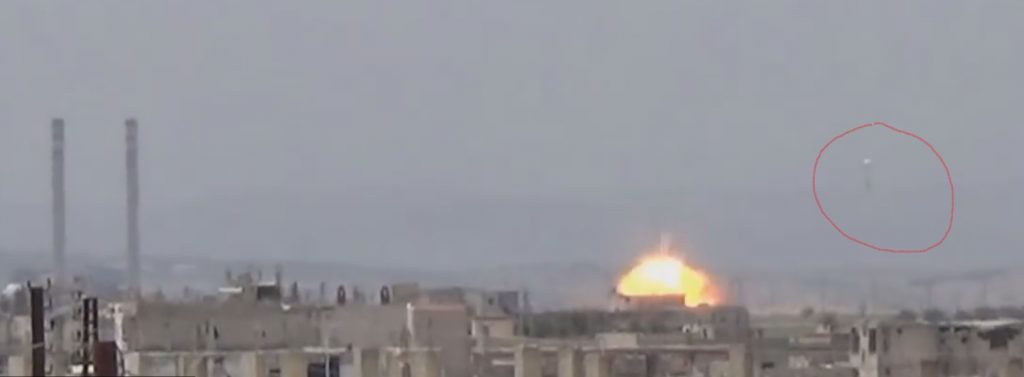
Figure 8. Thermobaric parachute bombs dropped on rebel’s positions near Latamneh (May 9, 2017).
For obvious reasons, massive air strikes and outstanding successes on the part of the aviation assets of the Syrian government forces are not likely any time soon, considering the current state of the conflict. In light of the material and manpower limitations of the SyAAF, the above highlighted successes should be viewed as significant tactical achievements.
The future of the Syrian Air Force
In the near future, Syria will find it very difficult to independently rebuild its Air Force. At present, they can perform their tasks only in close cooperation with the Russian Federation Air Force.
Before the Syrian crisis, the SyAAF had signed a contract to purchase 36 advanced Yak-130 jet trainers, several MiG-31s and 24 multi-purpose Mig-29m2 fighters, though deliveries of the aircraft have not commenced. It is believed that the Syrian state does not intend to take delivery of them at this moment due to a multitude of technical and financial problems which render the SyAAF incapable of operating the new warplanes under the current conditions. A number of unconfirmed reports have suggested that Russia intends on providing the SyAAF with ten Su-24 advanced tactical bombers to replace the losses suffered as a result of the US missile attack on Shayrat Airbase, thus raising the fighting proficiency level of the embattled air force. The presence of the Russian Federation Air Force and the renewal of the Syrian Air Force frontline combat aircraft will make it possible to drastically reduce the use of light training aircraft such as the L-39, in an active combat role over the battlefield.
It can be said that the Syrian Air Force accorded itself well during this war, especially considering its limited capabilities in manpower and available, modern combat aircraft. Due to a multitude of political and financial pressures, the SyAAF was unable to take delivery of even a single modern combat aircraft since 1990. Regardless, the SyAAF has proven capable of utilizing the available resources at its disposal to carry out over 100 combat sorties on a daily basis, spanning the majority of the country’s airspace, while also performing transportation and reinforcement missions continuously for over six years of a brutal conflict.



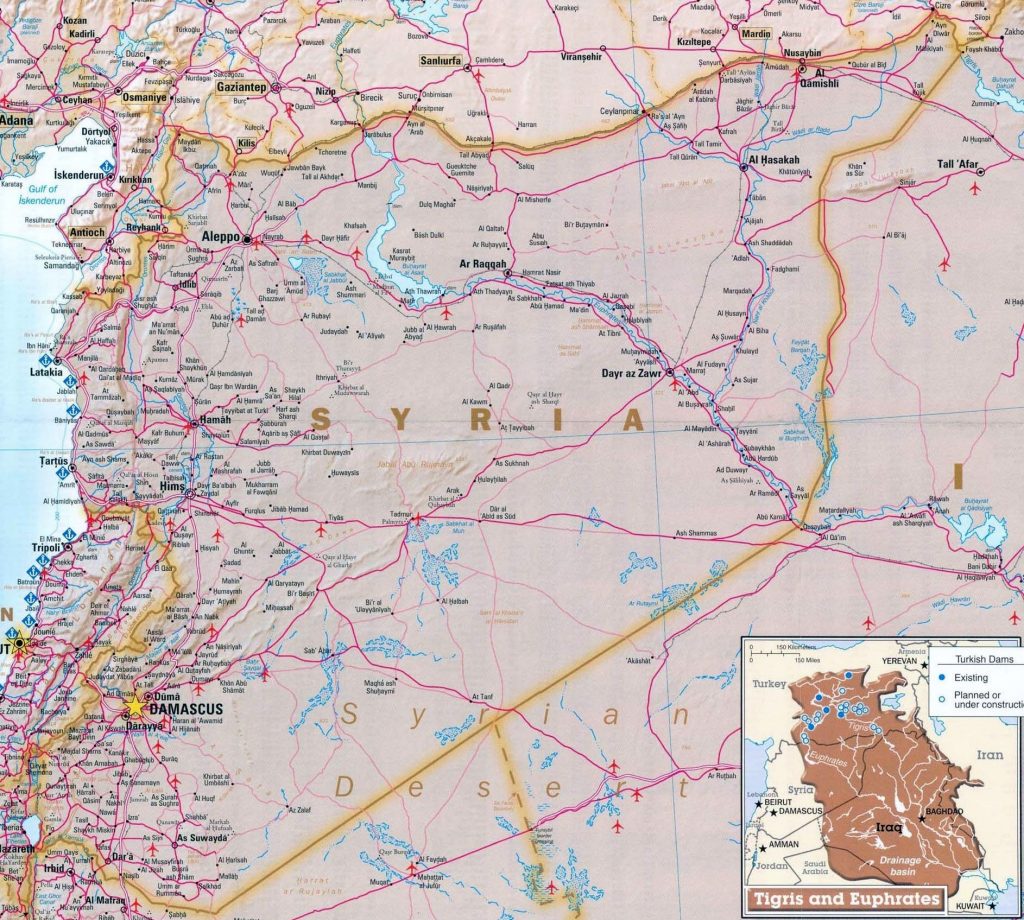



Well, Assad better updates the Air Force with the latest high tech airplanes and Air Defence System. Otherwise he is looking for trouble. Country with weak military always will be target
Syria is fighting ALL Suny Monarquies, ISIS, Rebels, AND USA backing them all…
aaaaaaaaaaand?
Solomon Krupacek
“…aaaaaaaaaaand?…”
On a global scale with the blessing of the “Terror Axis” countries, US, UK, France, EU, NATO, Turkey, Saudi, Qatar, Arabs, etc who arm, train and finance terrorism there are MILLIONS of Islamic terrorists waiting to go to Syria.
Saudi Arabia alone has spent upwards of US$80 Billion funding mosques and schools around the world which are the breeding ground for the “Terrorist Conveyor Belt”, as one terrorist drops off “Martyrs” another two terrorists are ready to take his / her place.
Additionally, Saudi, Qatar and other countries have spent upwards of US$30 Billion in financing IS – Islamic State, the “Terrorist Conveyor Belt” in Syria.
Regarding Syria, there are many 100,000s’ plus IS terrorists located between Idlib through to the Iraq border and Mosul and south towards Deraa.
Based on BBC TV news approx 40,000 “fighters” (IS terrorists) and their families had safe passage from Aleppo to Idlib in 2016.
So there must be a very large amount of terrorists biding time in Idlib and moving back and forth between the facilitator of terror, Turkey.
Regarding Palmyra v2, out of 4,500 IS there are Reports that 2,500 have been killed which would leave another 2,000 IS terrorists loose in the Palmyra Homs area alone.
Confirmation *There are 100’s more in the MSM just google:
Qatar and Saudi Arabia ‘have ignited time bomb by funding global spread of radical Islam’
http://www.telegraph.co.uk/news/worldnews/middleeast/iraq/11140860/Qatar-and-Saudi-Arabia-have-ignited-time-bomb-by-funding-global-spread-of-radical-Islam.html
http://www.belfasttelegraph.co.uk/news/world-news/rogue-game-in-syria-claims-ankara-worked-with-us-and-uk-to-smuggle-gaddafis-weapons-to-jihadi-fighters-and-jabhat-alnusra-aided-by-turkish-intelligence-in-sarin-gas-attacks-30183069.html
Gaddafi’s weapons to jihadi fighters, and Jabhat al-Nusra aided by Turkish intelligence in sarin gas attacks
Iraq crisis: Sunni caliphate has been bankrolled by Saudi Arabia
http://www.belfasttelegraph.co.uk/opinion/columnists/robert-fisk/iraq-crisis-sunni-caliphate-has-been-bankrolled-by-saudi-arabia-30351679.html
you should spare with breath.
aaaaaand? how wlii this: Syria is fighting ALL Suny Monarquies, ISIS, Rebels, AND USA backing them all.” negate, what jo doe told?: “Assad better updates the Air Force with the latest high tech airplanes
and Air Defence System. Otherwise he is looking for trouble. Country
with weak military always will be target”
sorry, i did not read your blabla :)
Solomon Krupacek
“…”Assad better updates the Air Force with the latest high tech airplanes
and Air Defence System….”
OK, easy words:
2017, Syria has no money to buy fighter jets or SAMs.
Even Russian SU’s are flying with empty cannons., LoL:)))
2017, Arab Monarchies, spend US$100’s Billions, Saudi’s latest deal US$350 Billion with USA.
Just another brainless troll, looking for attention his dad isnt giving him.
Unless Russia steps in for u. Which they have done. So in future, nations will think twice before messing with Syria.
Since Russia has no MiG-23 or Su-22 to give away it should give Syria more L-39 to be used as light atack aircraft. They are ideal to support advancing troops and to search end destroy soft targets with rockets.
L-39 is really bad idea. Easy to take down, no defense system, little attack capacizy. the plane is cheap, but the pilot not ;)
L-39 is czechoslovakia airplane. You may have in mind Yak-130
i know l-39
not really combat plane
L39 is harder to shoot down than attack choppers. and if easy to fly then there are many pilots who can.
look, inmy relatives i have pilot. and he learned on l-39. i trust him. technically you cab use to deliver some missiles, some little bombs, but the chopper is 1-2 classes better. and pilot is expensive “good”. with L-39 you need experienced pilto to hot the target. this light plane is not good for hypermodern weapon systems.
There are plenty experienced pilots without aircraft to fly now that US destroyed several MiG-23 and Su-22. Even if Russia supplies more Su-24, Syria would have to train co-pilots and that takes time. Putting Su-22 pilot to act as co-pilots would be a waste of humans resources since they could be used flying L-39 against terrorists wit good efect.
I´m talking about the L-39 since Russia is withdrawing the type from service to replace it with the Yak-130. It´s cheap and a good stopgap atack aircraft unlike the Yak-130.
Assad should realize without modernizing his military, Syria will be always target by enemy, such as Turkey, americans and Israel. He has to take loan from Russia as UK did in WW2 and buy high tech weapons. He lost more because of the war than what he will spend on high tech military hardware. In addition, Russia also need strong partner and Syria can’t always look to Russia for help
i dont think coming up with the money to pay for the weapons will be a problem for syria, as russia knows keeping syria well-defended is very important not just for syria’s sake but for russia as well, and iran. it’s bigger than just money.
either here, or in AMN i read, that the syrian government pays in advance for russian weapons. only 1 batch got in autumn with payment allowed in the future. mayby iran pays. but russia sure does not give large amounts gratis.
they should, winning against terrorists and zionists is more important than money right now
but russia has also not a lot of money :(
dont know about that but US also doesnt, we are $20 trillion in debt lol
this debt nothing. the germans have much more in gdp relation. until the russian oligarch their profit put in american banks and in dollar instead of rubel un russian banks, america is not endangered with their debt. china, eu are in worse conditions.
As you said , this debt is nothing . Considering that the oil under the Golan Heights is in a “strata” estimated to be 1000 feet thick . That it is considered to have the equivalent of Saudi’s fields . Israel and Syria will negotiate a 50/50 split , or some such reasonable truce to this war . But only if Syria is Master of Its Sky .
my words. :)
LOL is that why theyre creating belt/silk road? i dont see them coming to america for money, do u? u really have no idea what ur talking about
look at chinese firms.
what about them?
where are eypanding, where buy immobolities
Yes they are buying up things in america, which means they have money
sure. and they can escape in america. ;) so, america now is on top 1st place with its dollar.
Uhh not really
OK, tell us the truth. :)
Truth is west is broke and east is rising
:))))))))))))))))))))))))))))))))))))))))))))))))))))
weapons are not enough. the thinking of people is more important. such soldiers. who were in palmyra in nuumber 4 000 and ran 100 kms up to T4??? the west side of palmyra are hilltops, god dfense line could be build up. russian and syrian planes had chance help within 30 min. so, there are muchbigger problems than weapons. for such idiots i would never give modern weapons in hands.
Right now Syria needs equipments that already reached IOC within its armed forces meaning Su-24, L-39, Mi-8 and Mi-24. Right now the goal is to win the war. Modernization may come in the future with equipments Russia tested in the conflict.
Good aircraft, Czech friends say precisely the same thing, because Czechs are still making them, Zeman is on good terms with Assad, and increasingly, Czechs themselves, outside Prague, which is heavily Americanized, are pro_Russian, but it is a Czech, not Russian frame, and still being made.
The most obvious hole in the Syrian inventory is su-25. why did they choose su-24 over su-25?
Because they already operate Su-24s. Syria don´t need another model of aircraft right now, only the ones it operates.
I´m not talking about newly made czech aircraft but older ones Russia is retiring from training units. They could be quickly weaponized and sent to Syria.
10 or more Su 24 would be quality forward. ..as Syrian technicians know this aircraft well ,with pilot
Base to train future operators.
Syria needs MI 35 (reasonably they cannot afford the new Gen Russian attack Helicopters.
Su 25 with jamming pods would also bridge Syria’s TAC air until future financial recovery.
Russian attack Helicopters are bringing the hurt to the ISUS and US/FSA
https://youtu.be/2HSAudKHu4Y
This was an excellent article with much information. Thank you author.
After this, perhaps Russia will help Syria with a new air-force. And perhaps Iran will start a manufacturing facility for helicopters in Syria as well.
Real Anti-Racist Action
“…After this, perhaps Russia will help Syria with a new air-force….”
Unfortunately Russia is doing the minimum now for Syria.
Whilst the “Terror Axis” countries are doing the maximum for Terrorists.
Yet the Syrians are winning.
1. Russia provides massive air support.
2. Russia lost soldiers in Syria.
3. Russia supplies weapons to the Syrian army.
4. Russia trains Syrian soldiers.
Thanks to all this help Syria wins the war.
What else do you want Russia to do for Syria?
This is a very good article.
If Syria falls, eventually it will lead to the collapse of both Iran and the Russian Federation.
Sadly Syria has very little cash available now to finance its Air Force.
Both Russia and Iran are doing the minimum for Syria which will eventually lead to the collapse of Mr Assad’s government and the Saudi, Qatar, Turk takeover of Syria.
On a global scale with the blessing of the “Terror Axis” countries, US, UK, France, EU, NATO, Turkey, Saudi, Qatar, Arabs, etc who arm, train and finance terrorism there are MILLIONS of Islamic terrorists waiting to go to Syria.
Saudi Arabia alone has spent upwards of US$80 Billion funding mosques and schools around the world which are the breeding ground for the “Terrorist Conveyor Belt”, as one terrorist drops off “Martyrs” another two terrorists are ready to take his / her place.
Additionally, Saudi, Qatar and other countries have spent upwards of US$30 Billion in financing IS – Islamic State, the “Terrorist Conveyor Belt” in Syria.
Regarding Syria, there are many 100,000s’ plus IS terrorists located between Idlib through to the Iraq border and Mosul and south towards Deraa.
Based on BBC TV news approx 40,000 “fighters” (IS terrorists) and their families had safe passage from Aleppo to Idlib in 2016. So there must be a very large amount of terrorists biding time in Idlib and moving back and forth between the facilitator of terror, Turkey.
Regarding Palmyra v2, out of 4,500 IS there are Reports that 2,500 have been killed which would leave another 2,000 IS terrorists loose in the Palmyra Homs area alone.
Confirmation *There are 100’s more in the MSM just google:
Qatar and Saudi Arabia ‘have ignited time bomb by funding global spread of radical Islam’
http://www.telegraph.co.uk/news/worldnews/middleeast/iraq/11140860/Qatar-and-Saudi-Arabia-have-ignited-time-bomb-by-funding-global-spread-of-radical-Islam.html
http://www.belfasttelegraph.co.uk/news/world-news/rogue-game-in-syria-claims-ankara-worked-with-us-and-uk-to-smuggle-gaddafis-weapons-to-jihadi-fighters-and-jabhat-alnusra-aided-by-turkish-intelligence-in-sarin-gas-attacks-30183069.html
Gaddafi’s weapons to jihadi fighters, and Jabhat al-Nusra aided by Turkish intelligence in sarin gas attacks
Iraq crisis: Sunni caliphate has been bankrolled by Saudi Arabia
http://www.belfasttelegraph.co.uk/opinion/columnists/robert-fisk/iraq-crisis-sunni-caliphate-has-been-bankrolled-by-saudi-arabia-30351679.html
SAA has done well and Russia needs to rearm the air force after the US sponsored terrorists are defeated.
The fact that the Syrian Air force exists after all the country has gone through is sufficient testimony to their efforts. As for the future, they just need to get to the finish line of what is going on now. Go SAA. I wish well to all.
Thank you SF for this great piece . Only fault being referring to this war as a civil – war , when in fact , it is a war of US/UK aggression against Syria .
The most important advantage the SAA has over the jihadists , by what ever name or banner , is their air force . Syria , Russia and Iran can not afford to let that advantage slip or falter . Rather it should be massively replenished .
RUAF , will know the appropriate jet fighters to supply and could select the appropriate helicopters , that they themselves are producing in large numbers with Iran .
Importantly , the Iranian , RQ 170 drone , could be mass produced , for surveillance , and combat .
In humble appreciation , I give thanks and send courage to the Syrian Pilots !
At any time in their aviation history, including Assad’s father, were any air to ground weapons designed for chemical weapons delivery or were all of Syria’s chemical weapons arsenal designed to be delivered via long range Scud missiles?
My interest in this question should be obvious. The U.S. claims that Assad used an Su-24 (or 22) to attack Khan Shaykhun but if there is no history of Syria ever designing such a weapon then the U.S. is claiming that the Syrians designed and used a new delivery system instead of something they are already familiar with.
Can’t Syria buy on loan Iranian UAVs? How are they inferior to expensive jet planes?
Unlike manned aircraft, they can penetrate AA defenses because of their size.
if they get shot down, no harm to a soldier.
If they penetrate defenses, they are effective in killing combatants on the ground.
UAVs can be delivered to fighting areas by planes that don’t have to go into the war zones. There are also long range UAVs that can be deployed more than 100 km away.
They can also provide reconnaissance information.
They can do pinpoint attacks that minimize civilian casualties.
They are cost-efficient as I have said.
The Syrian Government would do well to invest in thousands of them and train operators to use them and conduct the rest of the war like this.
Tracking SDF, ISIS, FSA and anyone who is an enemy, on the ground and zapping them.
سلام.خواستم بابت وبسایت خوبتون ازتون تشکر کنم و امیدوارم باعث ایجاد انگیزه براتون
بشه
بهترین وبسایتی که تاحالا دیدم.ازتون متشکرم
مطلب بسیار خوبی بود.ممنون
best new site